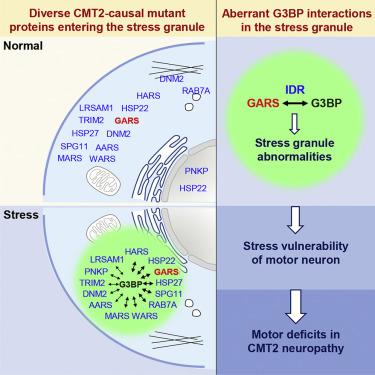Cell ( IF 45.5 ) Pub Date : 2023-02-03 , DOI: 10.1016/j.cell.2022.12.046 Qinqin Cui 1 , Hongyun Bi 1 , Zhanyun Lv 1 , Qigui Wu 2 , Jianfeng Hua 1 , Bokai Gu 1 , Chanjuan Huo 3 , Mingmin Tang 4 , Yanqin Chen 5 , Chongjiu Chen 3 , Sihan Chen 3 , Xinrui Zhang 3 , Zhangrui Wu 3 , Zhengkai Lao 3 , Nengyin Sheng 6 , Chengyong Shen 7 , Yongdeng Zhang 5 , Zhi-Ying Wu 8 , Zhigang Jin 9 , Peiguo Yang 5 , Huaqing Liu 10 , Jinsong Li 2 , Ge Bai 1

|
Complex diseases often involve the interplay between genetic and environmental factors. Charcot-Marie-Tooth type 2 neuropathies (CMT2) are a group of genetically heterogeneous disorders, in which similar peripheral neuropathology is inexplicably caused by various mutated genes. Their possible molecular links remain elusive. Here, we found that upon environmental stress, many CMT2-causing mutant proteins adopt similar properties by entering stress granules (SGs), where they aberrantly interact with G3BP and integrate into SG pathways. For example, glycyl-tRNA synthetase (GlyRS) is translocated from the cytoplasm into SGs upon stress, where the mutant GlyRS perturbs the G3BP-centric SG network by aberrantly binding to G3BP. This disrupts SG-mediated stress responses, leading to increased stress vulnerability in motoneurons. Disrupting this aberrant interaction rescues SG abnormalities and alleviates motor deficits in CMT2D mice. These findings reveal a stress-dependent molecular link across diverse CMT2 mutants and provide a conceptual framework for understanding genetic heterogeneity in light of environmental stress.
中文翻译:

多种 CMT2 神经病与应激颗粒中异常的 G3BP 相互作用有关
复杂疾病通常涉及遗传和环境因素之间的相互作用。Charcot-Marie-Tooth 2 型神经病 (CMT2) 是一组遗传异质性疾病,其中相似的周围神经病理是由各种突变基因莫名其妙地引起的。它们可能的分子联系仍然难以捉摸。在这里,我们发现在环境压力下,许多引起 CMT2 的突变蛋白通过进入应激颗粒 (SG) 具有相似的特性,在那里它们与 G3BP 异常相互作用并整合到 SG 通路中。例如,甘氨酰-tRNA 合成酶 (GlyRS) 在应激时从细胞质转移到 SGs,其中突变体 GlyRS 通过异常结合 G3BP 扰乱以 G3BP 为中心的 SG 网络。这会破坏 SG 介导的应激反应,导致运动神经元的应激脆弱性增加。破坏这种异常的相互作用可以挽救 SG 异常并减轻 CMT2D 小鼠的运动缺陷。这些发现揭示了不同 CMT2 突变体之间的压力依赖性分子联系,并为理解环境压力下的遗传异质性提供了概念框架。











































 京公网安备 11010802027423号
京公网安备 11010802027423号